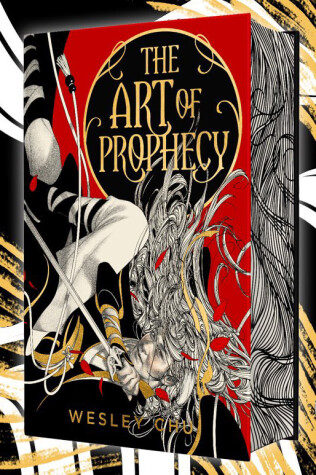
chymerra
I love long books, but only if they are well-written. I have read books (not this one, thankfully) that are well over 500 pages, and they ramble, but that is not the case with The Art of Prophecy. This book is 528 pages which kept me captivated to the very end.
The Art of Prophecy had an exciting plotline. Taishi, a grandmaster of marital arts who controls the element of wind, has arrived to evaluate Jian, who is prophesied to defeat the Eternal Khan. She finds a spoiled brat who can barely do martial arts or fight. When an ordinary soldier kills the Eternal Khan, Taishi finds herself doing the unexpected; saving Jian and hiding him away from people who want him dead. After a few months on the run, Taishi decides that Jian would be better hidden in plain sight and leaves him with another grandmaster. There, she hopes he will learn the discipline that he needs. But she also has an ulterior motive. Taishi will find the sect of monks who originally wrote the prophecy and see what it says. But it isn’t going to be easy for both Taishi or Jian. Jian has to deal with a school where people see him as a joke, and he cannot display any knowledge of fighting. If he does, his cover is broken. Taishi must stay one step ahead of the assassins sent to kill her. Add a morally gray character (Saliminde) whose only wish is to free her people and a psychotic bounty hunter (Qisami), and there is no telling what could happen. Can Jian stay hidden? Can Taishi find the monks and figure out the prophecy? Will Saliminde’s people be free? And will Qisami get her bounty?
As I stated in the opening paragraph, this is a long book. So, if you are going to read it, make sure you settle in for a while. Because I can guarantee you that once you start, you will not be able to put it down. That is a promise.
I loved that this book was set in an alternative (fantasy) China. The author did an excellent job of building up that world. It wasn’t an easy world to live in. It was violent, and the people lived under the constant threat of war. But, saying that, I would love to visit it!! The descriptions of blade dancing on the grass of the Grass Sea and its floating cities captivated me.
There are three (and, towards the end, four) main characters in The Art of Prophecy. They were all well-written and had their distinct personality. The characters are:
- Taishi. I didn’t like her at first. She did come across as pompous and a little bit of a control freak. My dislike of her only lasted a short couple of chapters before I got glimpses into who the real Taishi was. That Taishi was a good person who wouldn’t let a child (who reminded her of her son) be killed. I also loved that she had a disability (she only could use one arm) and could still kick bad guys’ butts.
- Jian. I felt terrible for Jian up to the middle of the book. He was the Champion of the Five Under Heaven. He was supposed to kill the Eternal Khan. Instead, the Khan was killed, and Jian ended up on the run with Taishi. It was a rude awakening for him. For the first time in his life, Jian had to work for things. By the middle of the book, I started to get aggravated with him. He kept having a “woe is me” mentality and was a jerk to the other kids at the school. By the time he and Taishi were reunited, he had grown out of that, and I got a good glimpse into the man he was going to be.
- Saliminde. I liked her right from the beginning. She was The Viperstrike (head warrior) of the Great Khan’s army. Her weapon was one of the coolest ones I have ever seen described in a book. She was such a bad-a** that she decided she wouldn’t commit ritual suicide for the Eternal Khan. Instead, she was going to find the next Eternal Khan and free her people from slavery. She didn’t kill to kill; she had a code about it. By the end of the book, I couldn’t get enough of her scenes. That last fight scene with Taishi and Qisami was 100% epic.
- Qisami. Ok, so I wasn’t a big fan of her when she was introduced halfway through the book. She was 100% psychotic, and the author made no qualms about it. She didn’t care who she killed (a 300-year-old drugged-out monk, for instance). She loved it. I found her constant talking in the fight scenes distracting. But, she did give both Saliminde and Taishi a run for their money, fightwise. Her ability to move through the shadows was terrific. By the end of the book, I still didn’t like her but understood her motivations for looking for Jian and Taishi.
There were many notable secondary characters in The Art of Prophecy. Each character added flair and depth to the book. I hope that some of the characters showcased at the end of The Art of Prophecy are made into more mainstream characters in the next book.
The Art of Prophecy also featured a fantastic fantasy storyline with action and adventure. I haven’t read a book that featured martial arts as prominently as this book did, and I still liked it. As for the fantasy, I couldn’t get enough of the world that the author had built up (if you can’t tell by me by fangirling this entire review).
As for the storylines, I LOVED them. There were some that I wished were expanded more upon (like Qisami’s origins) and some that I could have done without (the mapmaker), but they made the book.
The end of The Art of Prophecy was terrific. There was a truly epic fight scene where I did think one of the main characters had died. The author did not end any of the plotlines. Instead, he added to them during the last scenes of the book. Talk about making me want to read the second one!!!
Three reasons why you should read The Art of Prophecy:
- Amazing characters and storyline
- Martial Arts!!!
- Great world building
Three reasons why you should not read The Art of Prophecy:
- The book was super long (528 pages)
- A lot of graphic violence
- Some storylines could have been shortened or omitted.
